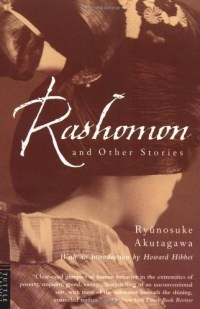
Translation by Takashi Kojima. Introduction by Howard Hibbett. First published by Tuttle Publishing in 1952. Akutagawa's stories were written in the first quarter of the Twentieth Century.
The Tuttle Classics edition of Rashomon contains six stories. "In a Grove" recounts a woman's rape and her husband's death from the conflicting perspectives of the rapist, the woman, and the husband, each of whom provides a different account of how the husband died. Akutagawa employs the same device -- telling a story from different perspectives -- in "Kesa and Morito": after a married woman has sex with a man who loathes her, they agree to murder her husband -- but the woman's vision of that crime is quite different from the man's.
"Rashomon" -- a meditation on good and evil, on desperation and hypocrisy -- tells of a servant who cannot decide whether to steal or starve until he meets an old woman who is pulling the hair out of corpses. Lacking compassion or empathy, he fails to recognize himself in her. Similarly, the Christian values of charity and forgiveness give way to hypocrisy in "The Martyr," as Jesuit missionaries and members of the Christian church in Nagasaki condemn a devout parishioner (Lorenzo) on the strength of rumored sin -- only later to declare Lorenzo a martyr after an act of self-sacrifice reveals Lorenzo's true (and surprising) nature.
"Yam Gruel" is the story of an aging samurai who, having been treated with contempt his whole life, clings to a dream -- to eat his fill of yam gruel -- until, finally given the opportunity to fulfill his desire, he questions whether he really wants to do so. In "The Dragon," a priest who is ridiculed because of his long nose decides to pull a prank on his fellow priests by posting a notice board that says "On March third a dragon shall ascend from this pond," only to find the prank taking on a life of its own.
I view these stories as the Japanese equivalent of western fables: teaching life's hard lessons by illustrating the misfortunes that come to those who behave badly. Each story has a moral. The lessons they teach transcend the differences between east and west: the seven deadly sins are just as deadly in Japan as they are in the United States.
Hibbet makes a convincing case that the stories in translation lose the nuances of language that convey the essence of the author's thought. While it is likely true that the stories are richer in Japanese, translation into English does not rob them of their power and vitality. They are a joy to read.
HIGHLY RECOMMENDED